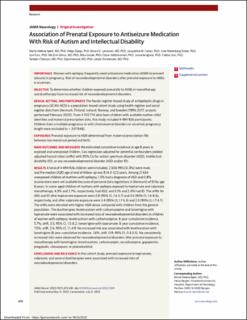| dc.description.abstract | Importance: Women with epilepsy frequently need antiseizure medication (ASM) to prevent seizures in pregnancy. Risk of neurodevelopmental disorders after prenatal exposure to AMSs is uncertain.
Objective: To determine whether children exposed prenatally to ASMs in monotherapy and duotherapy have increased risk of neurodevelopmental disorders.
Design, Setting, and Participants: The Nordic register-based study of antiepileptic drugs in pregnancy (SCAN-AED) is a population-based cohort study using health register and social register data from Denmark, Finland, Iceland, Norway, and Sweden (1996-2017; analysis performed February 2022). From 4 702 774 alive-born children with available mother-child identities and maternal prescription data, this study included 4 494 926 participants. Children from a multiple pregnancy or with chromosomal disorders or uncertain pregnancy length were excluded (n = 207 848).
Exposures: Prenatal exposure to ASM determined from maternal prescription fills between last menstrual period and birth.
Main Outcomes and Measures: We estimated cumulative incidence at age 8 years in exposed and unexposed children. Cox regression adjusted for potential confounders yielded adjusted hazard ratios (aHRs) with 95% CIs for autism spectrum disorder (ASD), intellectual disability (ID), or any neurodevelopmental disorder (ASD and/or ID).
Results: A total of 4 494 926 children were included; 2 306 993 (51.3%) were male, and the median (IQR) age at end of follow-up was 8 (4.0-12.1) years. Among 21 634 unexposed children of mothers with epilepsy, 1.5% had a diagnosis of ASD and 0.8% (numerators were not available because of personal data regulations in Denmark) of ID by age 8 years. In same-aged children of mothers with epilepsy exposed to topiramate and valproate monotherapy, 4.3% and 2.7%, respectively, had ASD, and 3.1% and 2.4% had ID. The aHRs for ASD and ID after topiramate exposure were 2.8 (95% CI, 1.4-5.7) and 3.5 (95% CI, 1.4-8.6), respectively, and after valproate exposure were 2.4 (95% CI, 1.7-3.3) and 2.5 (95% CI, 1.7-3.7). The aHRs were elevated with higher ASM doses compared with children from the general population. The duotherapies levetiracetam with carbamazepine and lamotrigine with topiramate were associated with increased risks of neurodevelopmental disorders in children of women with epilepsy: levetiracetam with carbamazepine: 8-year cumulative incidence, 5.7%; aHR, 3.5; 95% CI, 1.5-8.2; lamotrigine with topiramate: 8-year cumulative incidence, 7.5%; aHR, 2.4; 95% CI, 1.1-4.9. No increased risk was associated with levetiracetam with lamotrigine (8-year cumulative incidence, 1.6%; aHR, 0.9; 95% CI, 0.3-2.5). No consistently increased risks were observed for neurodevelopmental disorders after prenatal exposure to monotherapy with lamotrigine, levetiracetam, carbamazepin, oxcarbazepine, gapapentin, pregabalin, clonazepam, or phenobarbital.
Conclusions and Relevance: In this cohort study, prenatal exposure to topiramate, valproate, and several duotherapies were associated with increased risks of neurodevelopmental disorders. | en_US |

